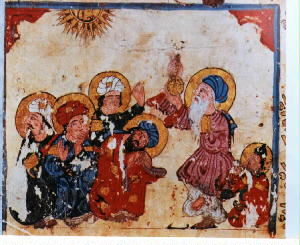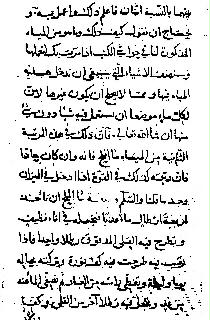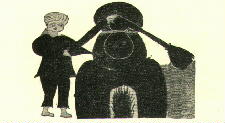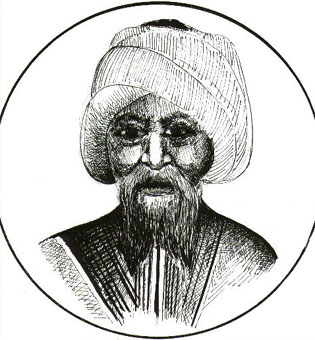Sunday, May 29, 2011
Simple Machines
How is Rain Formed?

Water in the Air
Rain is a form of precipitation in which water falls back to earth as a liquid. Precipitation that occurs in a solid form is snow or hail. There is always some water in the air, but the amount of water the air can hold depends mostly on temperature. Very warm air can contain more water than cooler air. Sudden drops in temperature can force water to fall, or precipitate, out of the air. In fact, this happens every morning when the cooler night air loses some of its moisture as dew.
The Water Cycle
Water moves on the earth in a great cycle. The water that falls as rain comes mainly from oceans, but also to a lesser extent from lakes and rivers. Heat from the sun causes water to evaporate, that is, to change phase and become a vapor. The water vapor rises and, as it does, reaches a level in the atmosphere where the temperature is cool enough for it to change back into a liquid. The change of phase from vapor to liquid is called condensation -- the exact same process that causes steam from a hot shower to fog up a cold mirror.
Water condenses in the air in tiny droplets about 1/100 of a millimeter in diameter, so small they remain aloft as clouds. Usually for rain drops to form there must also be small solid particles suspended in the air. If there air, the water droplets collect around these particles, growing larger and larger. When they are too heavy to remain in the sky, they fall back to earth as rain. The water then runs into lakes, rivers and ultimately the ocean, completing the water cycle.
Other Rain
Rain can also be produced by a process called seeding. Frozen particles of silver iodide, carbon dioxide or salt are released into the air, not only cooling it, but providing a substrate on which water droplets will condense. Cloud seeding is used in the United States to bring rain to drought-stricken areas, to prevent the formation of large hailstones, and to reduce fog around airports. The People's Republic of China has the largest cloud seeding program in the world. Prior to the 2008 Beijing Olympics, China launched rockets with silver iodide over Beijing to induce rain storms which cleared some of the city's notorious air pollution.
High levels of pollution in the atmosphere, especially sulfur and nitrogen, react to form acidic compounds. These can combine with water in clouds to create rain that falls to earth with unusually low pH, a phenomenon called acid rain. Acid rain has harmful effects on plants and animals, including humans, and can damage infrastructure and buildings.
Friday, May 27, 2011
History of Islamic Science
"It will suffice here to evoke a few glorious names without contemporary equivalents in the West: Jabir ibn Haiyan, al-Kindi, al-Khwarizmi, al-Fargani, al-Razi, Thabit ibn Qurra, al-Battani, Hunain ibn Ishaq, al-Farabi, Ibrahim ibn Sinan, al-Masudi, al-Tabari, Abul Wafa, 'Ali ibn Abbas, Abul Qasim, Ibn al-Jazzar, al-Biruni, Ibn Sina, Ibn Yunus, al-Kashi, Ibn al-Haitham, 'Ali Ibn 'Isa al-Ghazali, al-zarqab, Omar Khayyam. A magnificent array of names which it would not be difficult to extend. If anyone tells you that the Middle Ages were scientifically sterile, just quote these men to him, all of whom flourished within a short period, 750 to 1100 A.D."
Preface
On 8 June, A.D. 632, the Prophet Mohammed (Peace and Prayers be upon Him) died, having accomplished the marvelous task of uniting the tribes of Arabia into a homogeneous and powerful nation.
In the interval, Persia, Asia Minor, Syria, Palestine, Egypt, the whole North Africa, Gibraltar and Spain had been submitted to the Islamic State, and a new civilization had been established.
The Arabs quickly assimilated the culture and knowledge of the peoples they ruled, while the latter in turn - Persians, Syrians, Copts, Berbers, and others - adopted the Arabic language. The nationality of the Muslim thus became submerged, and the term Arab acquired a linguistic sense rather than a strictly ethnological one.
As soon as Islamic state had been established, the Arabs began to encourage learning of all kinds. Schools, colleges, libraries, observatories and hospitals were built throughout the whole Islamic state, and were adequately staffed and endowed.
In the same time, scholars were invited to Damascus and Baghdad without distinction of nationality or creed. Greek manuscripts were acquired in large numbers and were studied, translated and provided with scholarly and illuminating commentaries.
The old learning was thus infused with a new vigor, and the intellectual freedom of men of the desert stimulated the search for knowledge and science.
In early days at least, the Muslims were eager seekers for knowledge, and Baghdad was the intellectual center of the world.
Historians have justly remarked that the school of Baghdad was characterized by a new scientific spirit.
Proceeding from the known to the unknown; taking precise account of phenomena; accepting nothing as true which was not confirmed by experience, or established by experiment, such were fundamental principles taught and acclaimed by the the masters of the sciences.

- The time of Jabir Ibn Haiyan which covers the 2nd half of eighth century
- The time of Al-Khwarizmi which covers the 1st half of ninth century
- The time of Al-Razi which covers the 2nd half of ninth century
- The time of Al-Mas'udi which covers the 1st half of tenth century
- The time of Abu-l-Wafa which covers the 2nd half of tenth century
- The time of Al-Biruni which covers the 1st half eleventh century
- The time of Omar Khyyam which covers the 2nd half of eleventh century
The intellectual relaxation which characterized the second half of the seventh century and the first half of the eighth was followed by a period of renewed activity which was entirely due to Muslim initiatives, that is why this period gave an Arabic name marking the beginning of Muslim science. The name Jabir Ibn Haiyan came from the highly important contributions by him in this period. Jabir's texts, whether in Arabic or Latin, are one of the most urgent and promising tasks of scholarship. He will remain a very impressive personality.

Cultural Background of this Period in the East
Two rulers of the Abbasid caliphs used their authority to promote the intellectual welfare and progress of the peoples, and distinguished themselves greatly in this respect; the second, al-Mansur (founded Baghdad) and the fifth, Harun-al-Rashid (whose fame has been immortalized by many legends). Both caliphs encourage the work of translators who were busily unlocking the treasures of Greek knowledge.
Abu Ja'far 'Abdallah al-Mansur, i.e. the victorious. Died in 775 at Bir Maimun, near Mecca, at the age of 63 - 68 Muslim years (Hegra), i.e. 61-66 Christian years. He was the second 'Abbasid caliph and ruled from 754 to his death.
He was a great statesman and the founder of Baghdad. Memorable because of the many translations from the Syriac, Persian, Greek, and Hindu languages into the Arabic which were accomplished in his reign.
Harun al-Rashid, born in 763 or 766 at al-Ray; died at Tus in 809. Caliph from 786 to his death; the fifth and one of the greatest 'Abbasid monarchs. Magnificent patron of science, art, and literature. Many more Greek works were translated by his order. In 807 he presented a very remarkable water-clock to Charlemange (King of the Franks since 768; crowned Emperor of the West on Christmas 800 by Leo III in Rome)
Islamic Mathematics and Astronomy
All of the mathematical and astronomical work of this period was done by Muslims. It is interesting to recall that the mathematical work of the previous period had been done almost exclusively by Chinese. Some amount of stimulation had come from India. In addition to transmission of some Hindu mathematics.
Ibrahim al-Fazari is said to have been the first Muslim to construct astrolabes.
Ya'qub ibn Tariq and Muhammad, son of Ibrahim al-Fazari, are the first to be mentioned in connection with Hindu mathematics: Ya'qab met at the court of al-Mansur, a Hindu astronomer called Kankah (?), who acquainted him with the Siddhanta, and Muhammad was ordered to translate it. The physician al-Batriq translated Ptolemy's Quadripartitum. Two astrologers, one of them a Jew named Mashallah, the other a Persian called al-Naubakht, worked together to make the measurements necessary for the building of Bagdad. Al-Naubakht's son, al-Fadl, wrote astrological treatises and translations from the Persian into Arabic.
Ibrahim al-Fazari
Abu Ishaq Ibrahlm ibn Habib ibn Sulaiman ibn Samura ibn Jundab. Died c. 777.
Muslim astronomer. The first to construct astrolabes, he wa the author of a poem (qasida) on astrology and of various astronomical writings (on the astrolabe, on the armillary spheres, on the calendar). H. Suter: Die Mathematiker und Astronomer der Araber (3, 208, 1900)
Ya'qub Ibn Tariq
Probably of Persian origin, flourished in Baghdad, c.767-778 died c. 796. One of the greatest astronomers of his time. He probably met, c. 767, at the court of al-Mansur, the Hindu Kankah (or Mankah?), who had brought there the Siddhanta. He wrote memoirs on the sphere (c. 777), on the division of the kardaja; on the tables derived from the Siddhanta. H. Suter: Die Mathematiker und Astronomer der Araber (p. 4, 1900)
Muhammad Ibn Ibrahim Al-Fazari
Abu 'Abdallah Muhammad ibn Ibrahim al-Fazari. Son of the astronomer Ibrahim dealt with above, for whom he is sometimes mistaken (he may be the author of the astrological poem ascribed to his father). Died c. 796 to 806. Muslim scientist and astronomer. He was ordered by the Caliph al-Mansur in 772/3 to translate the Sanskrit astronomical work Siddhanta. This translation was possibly the vehicle by means of which the Hindu numerals were transmitted from India to Islam.
H. Suter: Die Mathematiker und Astronomen der Araber (p. 4,1900).
Cantor: Geschichte der Mathematik (I, 3rd ed., 698, 1907).
D. E. Smith and L. C. Karpinski: The Hindu-Arabic Numerals (p.92, Boston, 1911)
Mashallah
His real name was probably Manasseh (in Arabic, Misha). Latin translators named him Messahala (with many variants, as Macellama, Macelarma). Mashallah is a contraction of ma'aha Allah meaning "What wonders Allah has willed." (What hath God wrought.) Flourished under al-Mansur, died c. 815 or 820. One of the earliest astronomers and astrologers in Islam, himself an Egyptian (?) Jew. Only one of his writings is extant in Arabic, but there are many mediaeval Latin and Hebrew translations. The Arabic text extant deals with the prices of wares and is the earliest book of its kind in that language. He took part with the Persian astrologer al-Naubakht in the surveying preliminary to the foundation of Baghdad in 762-63. His most popular book in the Middle Ages was the 'De scientia motus orbis', translated by Gherardo Cremonese.
Text and Translation. The De scientia motus orbis is probably the treatise called in Arabic "the twenty-seventh;" printed in Nuremberg 1501, 1549. The second edition is entitled: 'De elementis et orbibus coelestibus', and contains 27 chapters. The De compositione et utilitate astrolabii was included in Gregor Reisch: Margarita phylosophica (ed. pr., Freiburg, 1503; Suter says the text is included in the Basel edition of 1583). Other astronomical and astrological writings are quoted by Suter and Steinsehneider.
An Irish astronomical tract based in part on a mediaeval Latin version of a world by Messahalah. Edited with preface, translation, and glossary, by Afaula Power (Irish Texts Society, vol. 14, 194 p., 1914. A relatively modern translation of the De scientia motus orbis, the preface is uncritical).


Islamic Alchemy
It is noteworthy that the earliest alchemical texts in Arabic and Latin are contemporaneous, that is, if our dating of them is correct. The most famous alchemist of Islam, Jabir Ibn Haiyan, seems to have had a good experimental knowledge of a number chemical facts; he was also an able theoretician.
Jabir ibn Haiyan
Abu Musa Jabir ibn Haiyan al-Azdi (al-Tusi, al-Tartusi; al-Harrani meaning that he was a Sabian?; al-Sufi). Flourished mostly in Kufa, c. 776, he was the most famous Arabic alchemist; the alchemist Geber of the Middle Ages. He may be the author of a book on the astrolabe, but his fame rests on his alchemical writings preserved in Arabic: the "Book of the Kingdom," the "Little Book of the Balances," the "Book of Mercy," the "Book of Concentration," the "Book of Eastern Mercury," and others. According to the treatises already translated (by Berthelot), his alchemical doctrines were very anthropomorphic and animistic. But other treatises (not yet available in translation) show him in a better light. We find in them remarkably sound views on methods of chemical research; a theory on the geological formation of metals; the so-called sulphur-mercury theory of metals (the six metals differ essentially because of different proportions of sulphur and mercury in them); preparation of various substances (e.g. basic lead carbonate; arsenic and antimony from their sulphides). Jabir deals also with various applications, e.g. refinement of metals, preparation of steel, dyeing of cloth and leather, varnishes to water-proof cloth and protect iron, use of manganese dioxide in glass making, use of iron pyrites for writing in gold, distillation of vinegar to concentrate acetic acid. He observed the imponderability of magnetic force.
It is possible that some of the facts mentioned in the Latin works, ascribed to Geber and dating from the twelfth century and later, must also be placed to Jabir's credit. It is impossible to reach definite conclusions until all the Arabic writings ascribed to Jabir have been properly edited and discussed. It is only then that we shall be able to measure the full extent of his contributions, but even on the slender basis of our present knowledge, Jabir appears already as a very great personality, one of the greatest in mediaeval science.
Text and Translations:- M. Berthelot: La chimie au moyen age (vol. 3, L'alchimie arabe, Paris,1893. The Arabic text of a few of Jabir's writings is edited by Octave Houdas. French translation, p. 126-224. See E. J. Holmyard's criticism in Isis, XI, 479-499, 1924). Ernst Darmstaedter: Die Alchemie des Geber (212 p., 10 pl.; Berlin, 1922. German translation of the Latin treatises ascribed to Geber; reviewed by J. Ruska in Isis, V, 451-455, concluding that these Latin treatises are apocryphal); Liber misericordiae Geber. Eine lateinisehe ubersetzung des grosseren Kitab al-rahma (Archive fur Geschichte der Medizin, vol. 17, 181-197, 1925; Isis, VIII, 737).

Page of one of Jabir's Chemical Works in Arabic

Figures of some Alchemical Processes in Arabic Manuscript

An illustration from an Arabic Manuscript in the British Museum

Portrait of Gaber Ibn Haiyan by an Egyptian artist
Imam Abu Yusuf's Biography
| Full name | Imam Abu Yusuf |
|---|---|
| Died | 798 |
| Era | Islamic Golden Age |
| Region | Muslim Jurist |
| School | Sunni Hanafi |
| Main interests | Islamic Jurisprudence |
| Notable ideas | Evolution of Islamic Jurisprudence |
Influenced by[show] | |
Yaqub ibn Ibrahim al-Ansari, better known as Abu Yusuf (Arabic: أبو يوسف) (d.798) was a student of legist Abu Hanifah (d.767) who helped spread the influence of the Hanafi school of Islamic law through his writings and the government positions he held.
Contents[hide] |
[edit]Biography
Abu Yusuf lived in Kufa and Baghdad, in what is now modern day Iraq, during the 8th century. His genealogy has been traced back to Sa'd b. Habta, a youth in Medina in the time of the Prophet, and his birth date is estimated based on his the date of his death to be around 113/729CE.[1]Based on anecdotal stories, Abu Yusuf was raised poor but with a ferocious appetite for knowledge. His father disapproved of his academic desires, insisting that he master some trade so as to help make ends meet. While it cannot be fully verified, stories suggest that he complied with his father's wishes, but also kept up his academic studies.[2] His talent and commitment was eventually recognized by Abu Hanifa who became his mentor with Abu Yusuf as his star pupil. He is portrayed as an incredibly studious individual who was unceasing in his pursuit for knowledge and legal understanding.[2] While much of what is known of his early childhood relies on sometimes contradictory anecdotal evidence, it has been verified that he studied religious law and traditions in Kufa and Medina under a number of scholars including Abu Hanifa, Malik b. Anas, al-Layth b. Sa'd and others.[1] Under the guidance of Abu Hanifa, Abu Yusuf achieved incredible success and helped develop and spread the influence of the Hanafi school of Islamic law.
Abu Yusuf lived in Kufa until he was appointed Qadi in Baghdad.[1] It is unclear whether he was appointed by Mahdi, al-Hadi, or Harun al-Rashid. According to one story, Abu Yusuf was able to provide sound advice pertaining to religious law to a government official who rewarded him generously and recommended him to the caliph, Harun al-Rashid.[1] He continued to provide satisfactory legal opinions to the caliph who drew him into his inner circle and eventually appointed him Qadi. While this version of events is probable, it is not necessarily authentic and cannot be independently verified. What is known is that Abu Yusuf became a close acquaintance of Abbasid caliph, Harun al-Rashid, who eventually granted him the title of GrandQadi, or Qadi 'l-qudat; the first time such a title had been conferred upon someone in Islamic history.[1] While at the time it was meant as an honorific title, the Caliph frequently consulted Abu Yusuf on legal matters and financial policy and even bestowed upon him the ability to appoint other Qadis in the empire. This made the position of Grand Qadi analogous to a modern day chief justice. Abu Yusuf held the position of Grand Qadi until his death in 182/798CE.[1]
[edit]Literary Works
During his lifetime, Abu Yusuf created a number of literary works on a range of subjects including Islamic jurisprudence, international law, narrations of collected traditions (ahadith), and others. The Kitāb al-Fihrist, a bibliographic compilation of books written in the 10th century by Ibn al-Nadim, mentions numerous titles authored by Abu Yusuf.[1] With one exception, none of these works listed in the Fihrist have survived. The exception is his book entitled Kitāb al-Kharāj, a treatise on taxation and financial issues facing the empire written at the request of the caliph, Harun al-Rashid.[3] The Islamic empire was at the height of its power at the time of his writing and in his treatise, he sought to advise the caliph on how to appropriately conduct financial policies in accordance with religious law. While the caliph took some suggestions and ignored others, the overall effect was to limit the ruler's discretion over the tax system.[4] A selection of other works credited to him that do not appear in the Fihrist have also survived. The Kitab al-Athar is a collection of Kufian traditions (ahadith) which he narrated.[1] Kitab Ikhtilaf Abi Hanifa wa Ibn Abi Layla is a comparison of the opinions between the legal authorities, Abu Hanifa and Abu Layla.[1] Kitab al-Radd ‘Ala Siyar al-Awza’i is a "reasoned refutation with broad systematic developments," of the opinions regarding the laws of war of the famous Syrian scholar, al-Awza’i.[1] Some excerpts from his various other works that have not survived in their totality were incorporated in texts written by his disciples and were passed on through succeeding generations. For example, excerpts from Abu Yusuf's book, Kitabal-Hiyal (Book of Legal Devices) were incorporated in the book, Kitabal-Makharidj fi 'l-Hiyal written by his disciple, Muhammad al-Shaybani.[1]
[edit]Doctrine and Methodology
As a disciple of Abu Hanifa, Abu Yusuf's doctrine largely presupposes that of his mentor. His writings and prominent political positions helped advance the Hanafi school of Islamic law throughout the Islamic empire.[3] While most of his legal opinions (fatwas) were firmly rooted in the doctrine and methodology espoused by his former teacher, there are some points on which he diverged and revealed his own legal thought. The doctrine of Abu Yusuf was more dependent on traditions (ahadith) than his master, in part because there were more authoritative prophetic traditions available to him in his time.[1] He also reacted against the somewhat unrestrained reasoning exhibited by Abu Hanifa. However, he was not always consistent; in a certain number of cases he disregarded sounder and more highly developed doctrine by diverging from the opinions of his former teacher.[1] Based on his surviving works and opinions, certain tendencies in Abu Yusuf's reasoning have been determined, such as his tendency to logically follow the implications of a proposition to an absurd conclusion (Reductio ad absurdum) and his use of rather caustic language in his attacks on opponents' positions and in defense of his own.[1] Abu Yusuf is also noted for the frequency in which he changed positions on various issues, which has been suggested is a result of his experience as a judge.[1] Abu Yusuf's greatest legacy is in affirming and advancing the Hanafi legal school as the predominant source of legal thought in the Islamic empire and providing a legal framework for defining and restricting caliphal authority in regard to fiscal policy.
[edit]List of Works
- Kitab al-Kharaj, his most famous work, is a treatise on taxation and fiscal problems of the state prepared for the caliph.[5]
- Usul al-fiqh - the earliest known work of principles of Islamic jurisprudence. A portion of his works were devoted to international law.[5]
- Kitab al-Athar, a collection of traditions (ahadith) he narrated
- Kitab Ikhtilaf Abi Hanifa wa Ibn Abi Layla, one of the early works on comparative Fiqh
- Kitab al-Radd ‘Ala Siyar al-Awza’i, a refutation of the famous Syrian jurist and tradition, al-Awza’i on the law of war.

